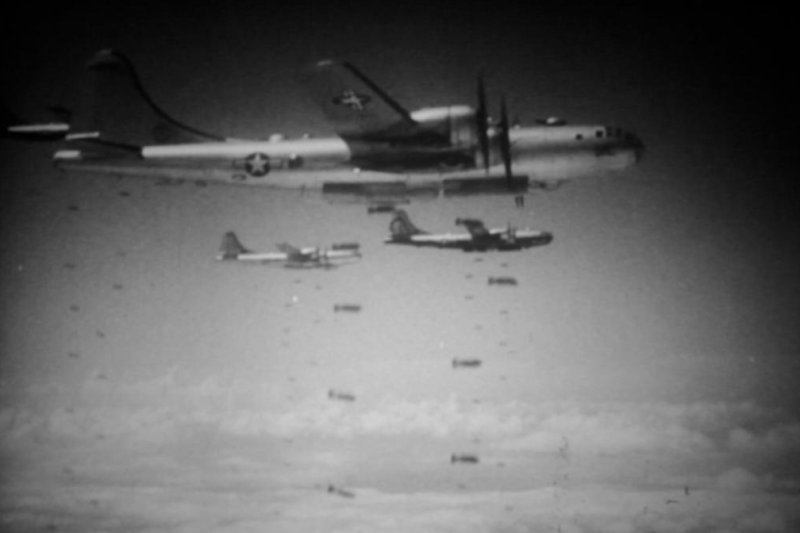Searing 'Scorched Earth' revisits American bombing campaigns in Korean War
By Thomas Maresca

Scorched Earth, a documentary by director Mi Young Lee, offers detailed accounts of the U.S. bombing campaign during the Korean War that devastated much of the peninsula.
Scorched Earth features declassified U.S. military footage along with pilot mission reports and testimony by South Korean survivors.
Refugees in both North and South Korea were killed by airstrikes during the 1950-53 war, which the documentary argues was the result of deliberate policies.
Screen capture courtesy of Busan International Film Festival/Mi Young Lee
The film, which premiered at the Busan International Film Festival on Saturday, is based on declassified U.S. military reports from over a million aircraft sorties, archival footage and testimonies from Korean survivors.
It paints a damning picture of the scorched-earth policy that used overwhelming air superiority against not just military targets but cities, villages, industrial facilities and dams -- as well as civilians in both North and South Korea.
.jpg)
Lee, a South Korean director and teacher based in Halifax, Canada, told UPI that the inspiration for this project came during the "fire and fury" period of 2017, when nuclear tensions were sky-high between the United States and North Korea.
"Friends and acquaintances in Canada asked me a question: why does North Korea hate the U.S. so much?" Lee said in an interview at the Busan festival.
"I was able to only give them very simple answers but I knew I needed to learn more about this history," she said. "I started to read Korean War history books and wanted to research more, and I ended up at the National Archives in D.C."
There she found troves of declassified material, including previously unreleased pilot mission reports that document or correlate accounts of bombings and strafing runs -- such as attacks on North Korean refugees crossing the Imjin River on Jan. 1, 1951.
"I think the U.S. government didn't know what kind of evidence was in those documents," she said. "It wasn't even organized -- just tons of papers in boxes, like finding a needle in a haystack."
The United States has never acknowledged a policy of targeting civilian populations during the Korean War. The Pentagon's 2001 investigation of a July 1950 wartime civilian massacre near the South Korean village of No Gun Ri concluded the killings were "not deliberate." (Scorched Earth starts with footage from a press conference by defense officials announcing the findings.)
In all, American planes dropped 635,000 tons of bombs on Korea -- including 32,557 tons of napalm -- more than was dropped in the entire Pacific theater of World War II. The majority of the war's victims were civilians, with as many as two million killed.
For the film, Lee pieced together the written records of the bombing campaigns with U.S. military film footage, some previously unseen, as well as newsreels and propaganda clips of the time.
She also turned to survivor accounts compiled by South Korea's Truth and Reconciliation Commission, which operated from 2005-10 and conducted investigations of civilian massacres during the Korean War.
Snippets of testimony are read in voiceover by South Korean students, with gruesome recollections of victims set ablaze by napalm, rolling in the dirt and crying out for water.
There are no Ken Burns-style reenactments, on-camera interviews or historians providing context in Scorched Earth. Instead, the film weaves an impressionistic tapestry of text, graphics and voices over grainy footage and an ominous, pulsating score -- an avalanche of information that at times overwhelms the emotional impact of the narrative.
The Korean conflict is often called the "forgotten war" in the United States but Lee argues that much about it has been systematically hidden, not just by Washington but Seoul as well.
For decades after the war, South Korea stifled public claims of civilian attacks under its draconian National Security Law -- creating a culture of silence that Lee said extended to her own grandmother, who lost three children to an airstrike.
"While I was researching all these records, I remembered my family's story, where my grandmother lost all three of her children during the war," Lee said. "My family never talked about it, I just vaguely heard it when I was a kid. It motivated me even more to complete this project."
Lee said she is currently working on a second film that focuses on specific airstrikes in South Korea and incorporates contemporary interviews with survivors, some of whom attended the Busan screening on Saturday.
"The immense sacrifice of these victims has almost been forgotten," Lee said. "This history should be spoken [about]. It's been 70 years, and while the Korean War survivors are still alive I think their stories should be made public. I think they want that, too."
Scorched Earth does not yet have a commercial release date. Lee said she plans to enter it on the festival circuit in North America.
.jpg)

No comments:
Post a Comment